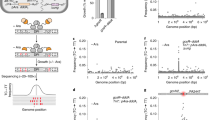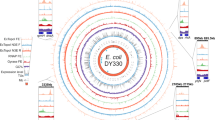Abstract
Rpn4p is a transcription factor responsible for coordinated regulation of proteasomal genes in Saccharomyces cerevisiae. There are data suggesting an involvement of this factor in regulation of many other genes that comprise more than one tenth part of the yeast genome. Traditional methods are inapplicable for mapping of Rpn4p binding sites because of their extremely low level. We have developed a model system using Dam-methylase of E. coli which allows us to detect interaction of Rpn4p with its target genes. In this system, we have shown that Rpn4p is recruited to proteasomal genes only through interactions with DNA.
Similar content being viewed by others
Abbreviations
- PACE:
-
Proteasome-Associated Control Element
- MACE:
-
MAG1-Associated Control Element
- DamID:
-
Dam identification method
References
Mannhaupt G., Schnall R., Karpov V., Vetter I., Feldmann H. 1999. Rpn4p acts as a transcription factor by binding to PACE, a nonamer box found upstream of 26S proteasomal and other genes in yeast. FEBS Lett. 450, 27–34.
Kapranov A.B., Kuryatova M.V., Preobrazhenskaya O.V., Tutyaeva V.V., Stucka R., Feldmann H., Karpov V.L. 2001. Isolation and identification of PACE-binding protein Rpn4, a new transcriptional activator regulating 26S-proteasomal and other genes. Mol. Biol. (Moscow). 35, 356–364.
Xie Y., Varshavsky A. 2001. RPN4 is a ligand, substrate, and transcriptional regulator of the 26S proteasome: A negative feedback circuit. Proc. Natl. Acad. Sci. U. S. A. 98, 3056–3061.
Gasch A.P., Moses A.M., Chiang D.Y., Fraser H.B., Berardini M., Eisen M.B. 2004. Conservation and evolution of cis-regulatory systems in ascomycete fungi. PLoS Biol. 2, e398.
Karpov D.S., Preobrazhenskaya O.V., Karpov V.L. 2009. Expression regulation of the proteasomal genes in eukaryotes. Mol. Biol. (Moscow). 43, 223–232.
Jelinsky S.A., Estep P., Church G.M., Samson L.D. 2000. Regulatory networks revealed by transcriptional profiling of damaged Saccharomyces cerevisiae cells: Rpn4 links base excision repair with proteasomes. Mol. Cell. Biol. 20, 8157–8167.
Owsianik G., Balzil L., Ghislain M. 2002. Control of 26S proteasome expression by transcription factors regulating multidrug resistance in Saccharomyces cerevisiae. Mol. Microbiol. 43, 1295–1308.
Hahn J.S., Neef D.W., Thiele D.J. 2006. A stress regulatory network for co-ordinated activation of proteasome expression mediated by yeast heat shock transcription factor. Mol. Microbiol. 60, 240–251.
Teixeira M.C., Dias P.J., Simoes T., Sa-Correia I. 2008. Yeast adaptation to mancozeb involves the up-regulation of FLR1 under the coordinate control of Yap1, Rpn4, Pdr3, and Yrr1. Biochem. Biophys. Res. Commun. 367, 249–255.
Harbison C.T., Gordon D.B., Lee T.I., Rinaldi N.J., Macisaac K.D., Danford T.W., Hannett N.M., Tagne J.B., Reynolds D.B., Yoo J., Jennings E.G., Zeitlinger J., Pokholok D.K., Kellis M., Rolfe P.A., Tak U.S., Agawa K.T., Lander E.S., Gifford D.K., Fraenkel E., Young R.A. 2004. Transcriptional regulatory code of a eukaryotic genome. Nature. 431, 99–104.
Zhu C., Byers K.J., McCord R.P., Shi Z., Berger M.F., Newburger D.E., Saulrieta K., Smith Z., Shah M.V., Radhakrishnan M., Philippakis A.A., Hu Y., De Masi F., Pacek M., Rolfs A., Murthy T., Labaer J., Bulyk M.L. 2009. High-resolution DNA-binding specificity analysis of yeast transcription factors. Genome Res. 19, 556–566.
Ju D., Wang X., Ha S.W., Fu J., Xie Y. 2010. Inhibition of proteasomal degradation of rpn4 impairs nonhomologous end-joining repair of DNA double-strand breaks. PLoS One. 5, e9877.
van Steensel B., Henikoff S. 2000. Identification of in vivo DNA targets of chromatin proteins using tethered dam methyltransferase. Nature Biotechnol. 18, 424–428.
Orian A., van Steensel B., Delrow J., Bussemaker H.J., Li L., Sawado T., Williams E., Loo L.W., Cowley S.M., Yost C., Pierce S., Edgar B.A., Parkhurst S.M., Eisenman R.N. 2003. Genomic binding by the Drosophila Myc, Max, Mad/Mnt transcription factor network. Genes Dev. 17, 1101–1114.
Bianchi-Frias D., Orian A., Delrow J.J., Vazquez J., Rosales-Nieves A.E., Parkhurst S.M. 2004. Hairy transcriptional repression targets and cofactor recruitment in Drosophila. PLoS Biol. 2, E178.
Song S., Cooperman J., Letting D.L., Blobel G.A., Choi J.K. 2004. Identification of cyclin D3 as a direct target of E2A using DamID. Mol. Cell Biol. 24, 8790–8802.
Holland S., Ioannou D., Haines S., Brown W.R. 2005. Comparison of Dam tagging and chromatin immunoprecipitation as tools for the identification of the binding sites for S. pombe CENP-C. Chromosome Res. 13, 73–83.
Lebrun E., Fourel G., Defossez P.A., Gilson E. 2003. A methyltransferase targeting assay reveals silencertelomere interactions in budding yeast. Mol. Cell Biol. 23, 1498–1508.
Venkatasubrahmanyam S., Hwang W.W., Meneghini M.D., Tong A.H., Madhani H.D. 2007. Genome-wide, as opposed to local, antisilencing is mediated redundantly by the euchromatic factors Set1 and H2A.Z. Proc. Natl. Acad. Sci. U. S. A. 104, 16609–16614.
Gietz D., St Jean A., Woods R.A., Schiestl R.H. 1992. Improved method for high efficiency transformation of intact yeast cells. Nucleic Acids Res. 20, 1425.
Ju D., Wang L., Mao X., Xie Y. 2004. Homeostatic regulation of the proteasome via an Rpn4-dependent feedback circuit. Biochem. Biophys. Res. Commun. 321, 51–57.
Ausubel F.M., Brent R., Kingston R.E., Moore D.D., Smith J.A., Seidman J.G., Struhl K. 1998. Current Protocols in Molecular Biology. NY: Wiley.
Christianson T.W., Sikorski R.S., Dante M., Shero J.H., Hieter P. 1992. Multifunctional yeast high-copy-number shuttle vectors. Gene. 110, 119–122.
Gietz R.D., Sugino A. 1988. New yeast-Escherichia coli shuttle vectors constructed with in vitro mutagenized yeast genes lacking six-base pair restriction sites. Gene. 74, 527–534.
Greil F., Moorman C., van Steensel B. 2006. DamID: Mapping of in vivo protein-genome interactions using tethered DNA adenine methyltransferase. Methods Enzymol. 410, 342–359.
Hoekstra M.F., Malone R.E. 1986. Excision repair functions in Saccharomyces cerevisiae recognize and repair methylation of adenine by the Escherichia coli dam gene. Mol. Cell Biol. 6, 3555–3558.
London M.K., Keck B.I., Ramos P.C., Dohmen R.J. 2004. Regulatory mechanisms controlling biogenesis of ubiquitin and the proteasome. FEBS Lett. 567, 259–264.
Karpov D.S., Osipov S.A., Preobrazhenskaya O.V., Karpov V.L. 2008. Rpn4p is a positive and negative transcriptional regulator of the ubiquitin-proteasome system. Mol. Biol. (Moscow). 42, 456–463.
Kladde M.P., Simpson R.T. 1994. Positioned nucleosomes inhibit Dam methylation in vivo. Proc. Natl. Acad. Sci. U. S. A. 91, 1361–1365.
Singh J., Klar A.J. 1992. Active genes in budding yeast display enhanced in vivo accessibility to foreign DNA methylases: A novel in vivo probe for chromatin structure of yeast. Genes Dev. 6, 186–196.
Author information
Authors and Affiliations
Corresponding author
Additional information
Original Russian Text © D.S. Spasskaya, D.S. Karpov, V.L. Karpov, 2011, published in Molekulyarnaya Biologiya, 2011, Vol. 45, No. 4, pp. 642–651.
Rights and permissions
About this article
Cite this article
Spasskaya, D.S., Karpov, D.S. & Karpov, V.L. Escherichia coli Dam-methylase as a molecular tool for mapping binding sites of the yeast transcription factor Rpn4. Mol Biol 45, 591–599 (2011). https://doi.org/10.1134/S0026893311030186
Received:
Accepted:
Published:
Issue Date:
DOI: https://doi.org/10.1134/S0026893311030186




